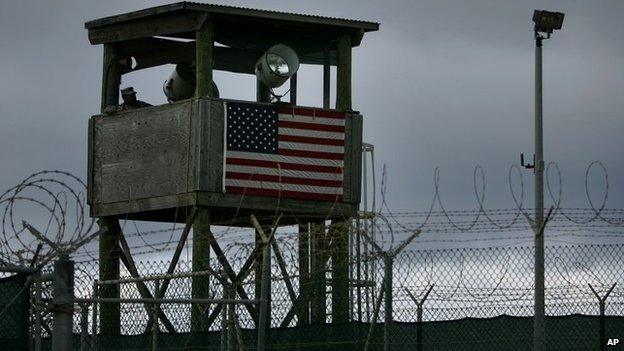Report on CIA details 'brutal' post-9/11 interrogations
- Published
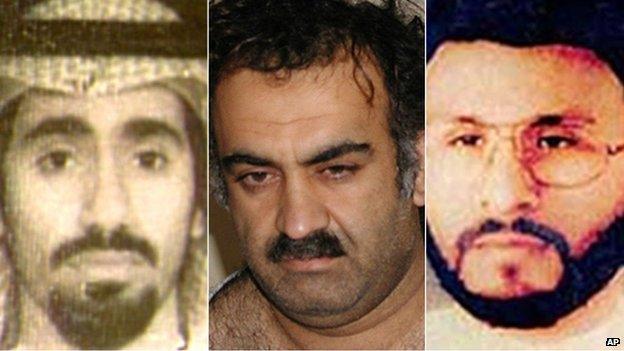
Abd- al-Rashim al-Nashiri, Khalid Sheikh Mohammed and Abu Zubaydah were captured and interrogated as part of the US fight against al-Qaeda
The CIA carried out "brutal" interrogations of al-Qaeda suspects in the years after the 9/11 attacks on the US, a US Senate report has said.
The summary of the report, external, compiled by Democrats on the Senate Intelligence Committee, said the CIA had misled Americans about what it was doing.
The information the CIA collected this way failed to secure information that foiled any threats, the report said.
In a statement, external, the CIA insisted the interrogations had helped save lives.
"The intelligence gained from the programme was critical to our understanding of al-Qaeda and continues to inform our counterterrorism efforts to this day," director John Brennan said.
However, the CIA also acknowledged mistakes in the programme, especially early on when it was unprepared for the scale of the operation to detain and interrogate prisoners.
The CIA programme - known internally as Rendition, Detention and Interrogation - took place from 2002-07, during the presidency of George W Bush.
The report reveals that:
Detainees were subjected to repeated waterboarding, slapping, stress positions and sleep deprivation
Saudi al-Qaeda suspect Abu Zubaydah was kept confined in a coffin-sized box for hours on end
Suspects were threatened with severe harm - psychologically and physically

Analysis: Frank Gardner, BBC security correspondent
This report makes deeply uncomfortable reading but it shines a much-needed torch into some dark places.
The fact that Enhanced Interrogation Techniques, or torture by any other name, was stopped years ago or that some people at the top of the US administration may not have known its full extent, does not excuse the fact it took place at all.
After going through six million pages of documents, the authors concluded that in none of the cases they had looked at did these brutal methods stop a terrorist attack. Meaning that America's reputation, and by extension that of the wider West, has been sullied for no tangible gain.
This will lay the US open to charges of hypocrisy, making it far harder for the West to criticise brutal and dictatorial regimes. It may also encourage terrorists to justify their atrocities by pointing to this past abuse.
It can only be hoped this report's publication means these practices will be consigned to history's dustbin.

'Significant damage'
Introducing the report to the Senate, Intelligence Committee Chairwoman Dianne Feinstein described the CIA's actions as a "stain on US history".
Dianne Feinstein said it was time to face the "ugly truth"
"The release of this 500-page summary cannot remove that stain, but it can and does say to our people and the world that America is big enough to admit when it's wrong and confident enough to learn from its mistakes," she said.
"Under any common meaning of the term, CIA detainees were tortured," she added.
Earlier, President Barack Obama said the methods used were inconsistent with US values.
"These techniques did significant damage to America's standing in the world and made it harder to pursue our interests with allies and partners," he said.
Reacting to the release of the report summary, the Senate Republican leaders insisted that the methods used had helped in the capture of important suspects and the killing of Osama bin Laden.
"Claims included in this report that assert the contrary are simply wrong," Senators Mitch McConnell and Saxby Chambliss said in a joint statement.
UK Prime Minister David Cameron said the issue had been "dealt with from a British perspective" but that torture was wrong.
"After 9/11 there were things that happened that were wrong - and we should be clear about the fact they were wrong," he said.
The Senate committee's report runs to more than 6,000 pages, drawing on huge quantities of evidence, but it remains classified and only a 525-page summary, external has been released.

Case study: Saudi terror suspect Abu Zubaydah

Described by US officials as al-Qaeda's former operational planner and terrorist recruiter, Abu Zubaydah was captured in Pakistan and sent to a secret facility in Thailand.
His cell was described as white with no natural light or windows, but with four lights pointing into the cell and an air conditioner.
He had two chairs, one more comfortable than the other, rotated based on his level of co-operation.
From 4-23 August 2002, following 47 days of complete isolation, Abu Zubaydah was subjected to EIT almost 24 hours a day.
Security personnel entered his cell, shackled and hooded him and removed his towel so that he was naked.
"Abu Zubaydah was typically kept naked and sleep-deprived," the report says.
He was backed up against the wall and a box laid on the floor to look like a coffin.
Whenever the suspect denied having certain information, the interrogators grabbed or slapped his face.
On the first evening, he was waterboarded, as a result of which he coughed, vomited and had spasms.
The sessions accelerated, progressing more quickly to waterboarding.
According to the report, the objective was "to ensure [he] is at his most vulnerable state", at all times.

Former CIA lawyer John Rizzo on 'enhanced interrogation': "I don't think I had any other choice."
The main points of the report include the following:
None of 20 cases of counterterrorism "successes" attributed to the techniques led to unique or otherwise unavailable intelligence
The CIA misled politicians and public, giving inaccurate information to obtain approval for using techniques
The CIA claimed falsely that no senators had objected to the programme
At least 26 of 119 known detainees in custody during the life of the programme were wrongfully held, and many held for months longer than they should have been
Methods included sleep deprivation for up to 180 hours, often standing or in painful positions
Waterboarding was physically harmful to prisoners, causing convulsions and vomiting
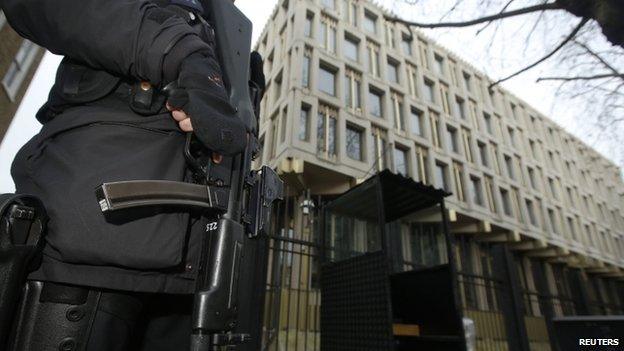
Armed police guard the US embassy in London, as part of enhanced security measures at US facilities worldwide
Mr Obama halted the CIA interrogation programme when he took office in 2009.
Earlier this year, he said that in his view the methods used to question al-Qaeda prisoners amounted to torture.
Publication of the report had been delayed amid disagreements in Washington over what should be made public.
Security was increased at US facilities around the world ahead of publication.
Embassies and other sites were taking precautions amid "some indications" of "greater risk", a White House spokesman said.
US Defence Secretary Chuck Hagel said he had ordered all top US military commanders to be on high alert.

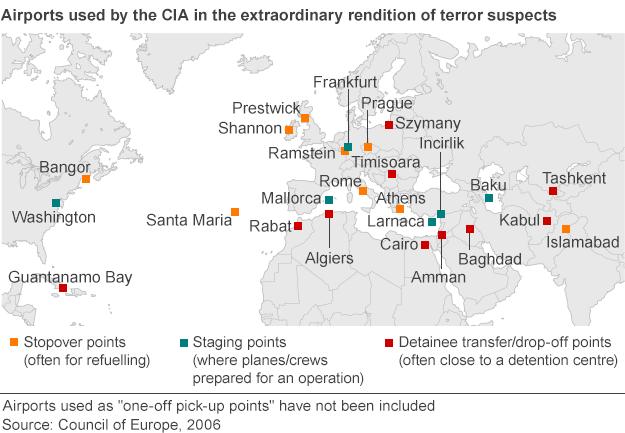
US intelligence agencies were accused of using "extraordinary rendition" to send terror suspects for questioning in countries where they had no legal protection or rights under American law. Some of the suspects claimed they had been tortured in countries such as Syria and Egypt.
A Council of Europe report in 2006 said it had pieced together details of a "spider's web of secret detentions and unlawful inter-state transfers", based on evidence from detainees' testimonies, flight plans and other publicly-available information.
The Senate report released on Tuesday said that the CIA had sent some of its al-Qaeda suspects to detention centres in other countries, but did not say which ones.
- Published9 December 2014
.jpg)
- Published9 December 2014
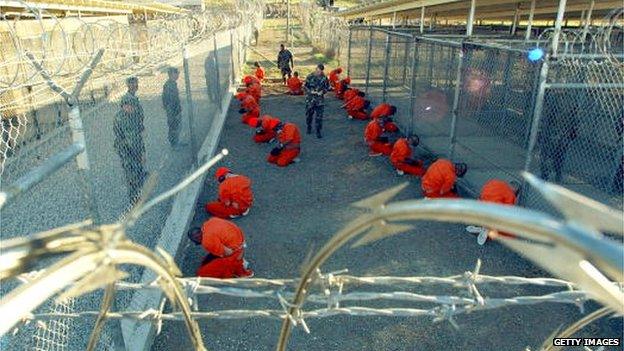
- Published9 December 2014
